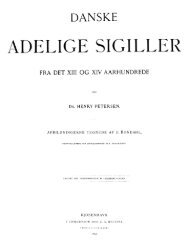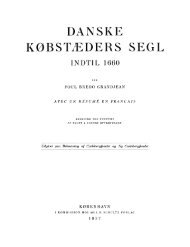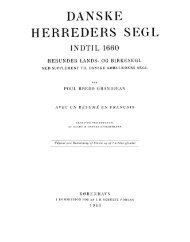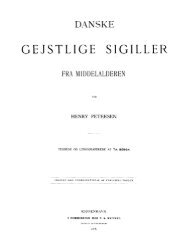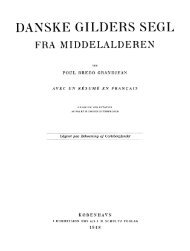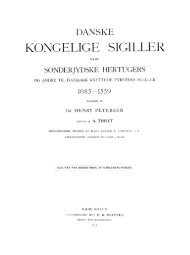Oldtidsagre - Genstandskundskab
Oldtidsagre - Genstandskundskab
Oldtidsagre - Genstandskundskab
You also want an ePaper? Increase the reach of your titles
YUMPU automatically turns print PDFs into web optimized ePapers that Google loves.
170 Nr.1<br />
the use of broad fields. On the other hand, the Germanic mould-board plough made<br />
possible the use of long and narrow fields.<br />
However, RIEITZEN has undervalued the tillage of the Roman farmers. The Romans<br />
possessed all the most important elements of the mould-board plough: the<br />
mould-board, the iron plough-share, and the coulter. This appears from the Roman<br />
agricultural litterature which BEHLEN cites in his book from 1904. Two mouldboards,<br />
one on each side of the plough, were used for the drawing of water-furrows<br />
(BEHLEN 1904, pp. 44-45). It is not so certain that a single m ould-board was used<br />
by the Romans (LESER 1931, p. 238). The eoulter is mentioned by PLINIUS in his<br />
description of the plough in Gallic Rhaetia (Historia naturalis XVIII, XLVIII). Tl1e<br />
coulter was hardly in general use in old Italy. Outside of Italy, however, in the northern<br />
provinces of the Roman empire, the coulter was used, as proven by<br />
archaeological finds (LESER 1931, pp. 232 seq.), e. g. in England (cf. above<br />
pp. 164-165).<br />
Two Roman authors are generally cited in support of the opinion that the Romans<br />
knew the wheel-plough. VERG11. (Georgica I, 169-175), describing the making<br />
of the plough from several kinds of wood, mentions wheels (currus). PLINIUS (Historia<br />
naturalis XVIII, XLVIII) relates that it has lately been invented in Gallic Rhaetia<br />
to give the plough two wheels, “quod genus vocant plaumorati". The word plaumorati<br />
contains apparently in its first syllable the same root as the word plough; for<br />
the rest, it is probably somewhat corrupt. Some people have wanted to find, in the<br />
last part of the word, the same root as in German “Rad”. Others have proposed to<br />
read the sentence this way, “quod genus vocant ploum Raeti", which would indicate<br />
a Rhaetian origin of the word plough (cf. BLOCH 1931, p. 53, note 43).<br />
Unfortunately, there is some doubt regarding the reading of both these sources.<br />
(Cf. (low 1914, pp. 271-275, and A. G. DRACHMANN,S article “Pflug" in PAULY<br />
\VISSO\VA 1936). If VERGIL knew the wheel-plough when he wrote Georgica, about<br />
30 B.C., it seems queer that PLINIUS could regard this implement as a new invention<br />
about a hundred years later.<br />
If, in spite of philological doubts, it may be admissible to draw any conclusions<br />
from the two sources, it should he observed that both \7ERGIL and Puxivs<br />
place the plough with wheels in Northern Italy. VERGIL knew from his childhood<br />
the region near l\lantua. Gallic Rhaetia was probably in Northern Italy. If the<br />
wheel-plough was known in Italy in antiquity, it was probably used only in the north.<br />
Then as now, the heavy plough could hardly be useful in the subtropical region<br />
of dry summers and wet winters. Implements of the arð-type are also in our days<br />
used in most of the Mediterranean region. It is probable, however, that heavy ploughs<br />
were used in Northern Italy when PL1N1us wrote. The heavy plough is mentioned<br />
by PLINIUS, not only in the famous passage about the Rhaetian plough, but also<br />
where he compares the tillage in Syria and Italy: “Syria quoque tenui sulco arat,<br />
cum multifariam in Italia octoni boves ad singulos vomeres anhelent" (Historia na



